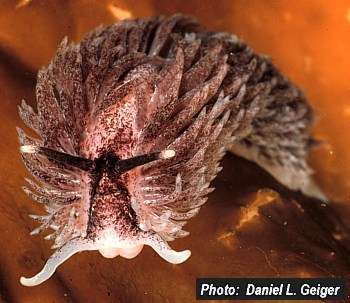
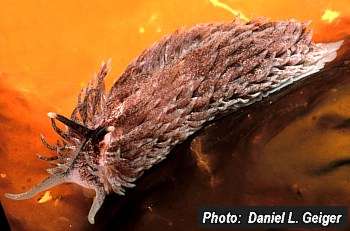
Aeolidia papillosa
(Linnaeus, 1761)
Order: NUDIBRANCHIA
Suborder: AEOLIDINA
Family: Aeolidiidae
DISTRIBUTION
Common on the Atlantic coast of Europe and North America and the Pacific coast of North America. Records apparently of this species from both west and east coasts of South America.
PHOTO
Millport, Isle of Cumbrae, Scotland, United Kingdom, May, 1992. on laminarian algae, sublittoral fringe. PHOTO: Daniel Geiger
RELATED TOPIC
Biology of Aeolidia papillosa - References
This large aeolid grows to about 120mm in length and its body is covered with close obliquely arranged rows of flattened cerata. Its size and relative abundance have made it a popular research animal with many studies on aspects of its biology, natural history and ecology. It appears to feed almost exclusively on sea anemones.
See Page 2.
Reference:
• Thompson, T.E. & Brown, G.H. (1984) Biology of Opisthobranch Molluscs, Vol 2. Ray Society: London.
Rudman, W.B., 1999 (August 8) Aeolidia papillosa (Linnaeus, 1761). [In] Sea Slug Forum. Australian Museum, Sydney. Available from http://www.seaslugforum.net/find/aeolpapi
Related messages
Aeolidia papillosa from French Atlantic
August 17, 2009
From: Marina Poddubetskaia Ossokine
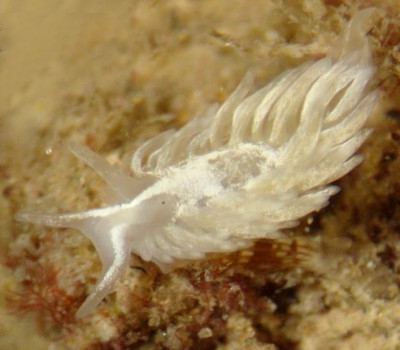
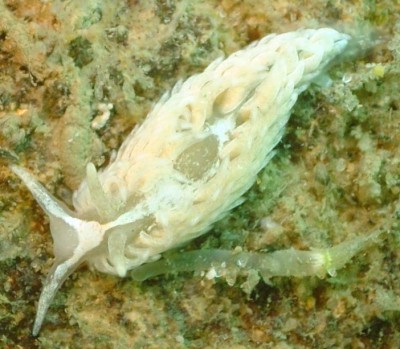
Dear Bill,
I know you have many photos of Aeolidia papillosa on the Forum but these animals from Arcachon Bay are so different from all of them, that firstly I didn't recognize them. Lucas Cervera identified it for me. So, I think it could be valuable to add this colour form to the Forum.
Locality: "Hortense Sud", Cap Ferret, Arcachon Bay, 5 m, France, Atlantic, 01 June 2009. Length: upper photo: 6 mm; other photos : 12 mm. Photographer: Marina Poddubetskaia.
Best wishes,
Marina.
Nembro website
nembro@yahoo.fr
Poddubetskaia Ossokine, M., 2009 (Aug 17) Aeolidia papillosa from French Atlantic. [Message in] Sea Slug Forum. Australian Museum, Sydney. Available from http://www.seaslugforum.net/find/22532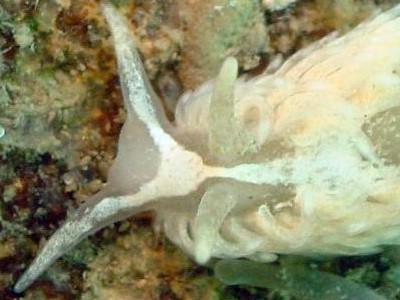
Thanks Marina,
I am surprised to see that most of our photos of this classic 'European' species come from the east coast of Nth America, so it is good to get a Mediterranean record to redress the balance. When I first saw your photos I was puzzled by the general shape until I realised these are quite juvenile specimens. The opaque white pigmentation forming a Y shape on the oral tentacles and head and leads back behind the rhinophores to form a large patch and a semicircular pattern is often lost or partially lost in larger animals, but Thompson & Brown (1984) considered it to be a useful identifying character in this species.
Best wishes,
Bill Rudman
Re: Aeolidia papillosa spawn
August 1, 2008
From: Jackie Hildering
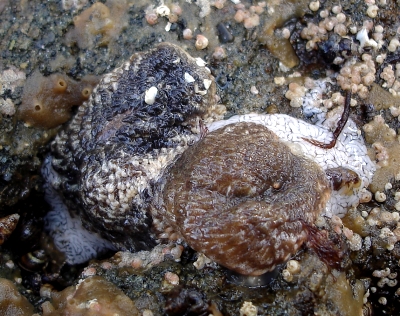
Concerning message #21519
As a follow-up to my previous message, another class (grade 9 science Port Hardy Secondary School), on another beach on Northern Vancouver Island, found Aeolidia papillosa mating.
Locality: Port Hardy, intertidal, British Columbia, Canada, Pacific Ocean, 10 April 2008, Intertidal. Length: 7 cm. Photographer: Jackie Hildering.
Jackie Hildering
earthlingenterprises@telus.net
Hildering, J., 2008 (Aug 1) Re: Aeolidia papillosa spawn. [Message in] Sea Slug Forum. Australian Museum, Sydney. Available from http://www.seaslugforum.net/find/21521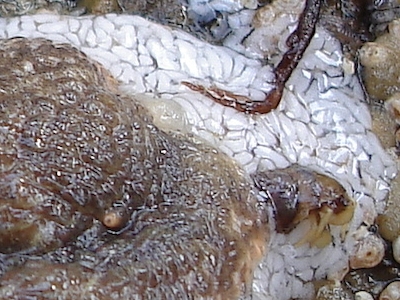
Dear Jackie,
Thanks so much. You can really see the tight morphology of the egg mass. There must be some 20 million eggs in this large mass.
Best wishes,
Dave Behrens
Re: Aeolidia papillosa spawn
August 1, 2008
From: Jackie Hildering
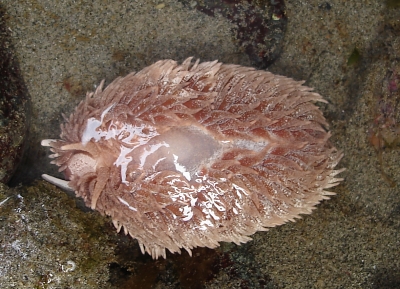
A group of grade 4 to 7 students from A.J. Elliot School in Sointula, British Columbia were observant enough to find Aeolidia papillosa and the species eggs. We believe they may be feeding on painted anemones (Urticina crassicornis) as we found one with a strip of painted anemone beside it (picture shows this poorly) and found the eggs beside an anemone of this species (interestingly this egg mass was pinker than the others).
Please might you be able to enlighten us how this species could feed on anemones i.e. how does it not get ingested? Does it go after the base of the anemone.
Locality: Sointula, 0 metres, British Columbia, Canada, Pacific Ocean, 9 April 2008, Intertidal. Length: 8 cm. Photographer: Jackie Hildering.
Great thanks,
Jackie Hildering
earthlingenterprises@telus.net
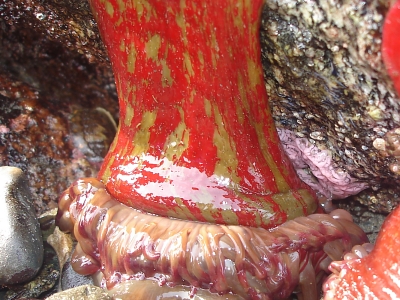
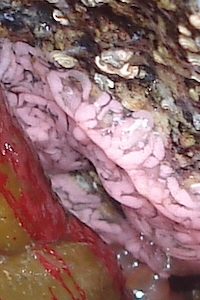
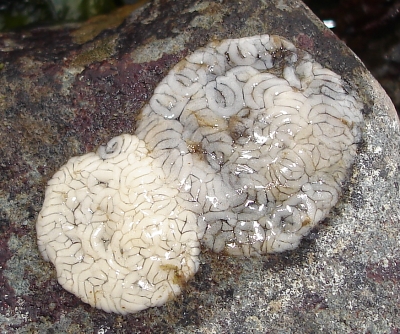
Dear Jackie,
Thanks for sharing this. There are 100's of references in the literature reporting the many foods of Aeolidia. Urticina crassicornis is one of the many species of sea anemone it feeds on.
As you suspected, the aeolid feeds only on the stalk, not the tentacles of the anemone. Other aeolids, do feed on cnidarian polyps and tentacles, however, without becoming prey themselves.
Best wishes,
Dave Behrens
Stars don't eat slugs
July 11, 2007
From: Jan Kocian
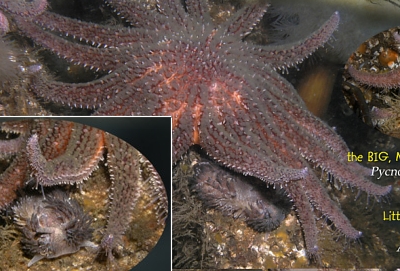
Another story from slug life on Whidbey Island. I was taking picture of Aeolidia papillosa when I saw a big starfish - Pycnopodia helianthoides - speeding down the piling in its usual arrogant manner. So I backed off and enjoyed the unfolding drama. When the star reached the slug, it stopped dead in the water, raising its arm and very gingerly probed the slug, it didn't look like it even touched. The slug completely ignored all the commotion behind it, waving arms and towering beast known as a voracious eater of almost everything.. Slugs are clearly not part of the indiscriminate diet of Pycnopodia helianthoides. I really enjoyed seeing the sea star slinking away sideways over much more inconvenient terrain. Another point for slugs !
Locality: Whidbey Island, Puget Sound, 10 feet, Washington, USA, Eastern Pacific Ocean, 07 February 2007, seawall pilings. Length: 45mm. Photographer: Jan Kocian.
Jan Kocian
honkoc@hotmail.com
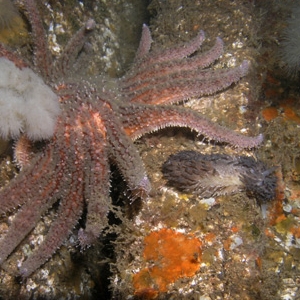
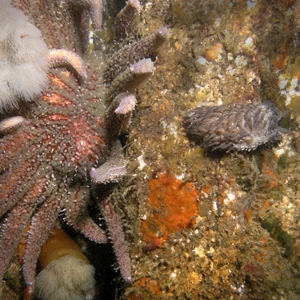
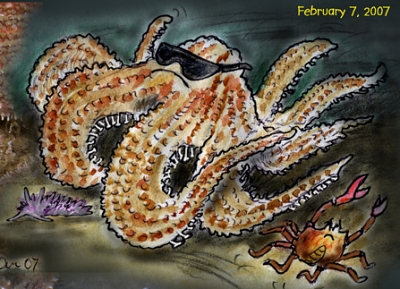
Thanks Jan,
Your Aeolidia is certainly made of sterner stuff than Jackie's dorid [message #20125]
Best wishes,
Bill Rudman
Aeolidia papillosa from British Columbia
March 26, 2007
From: Marli Wakeling
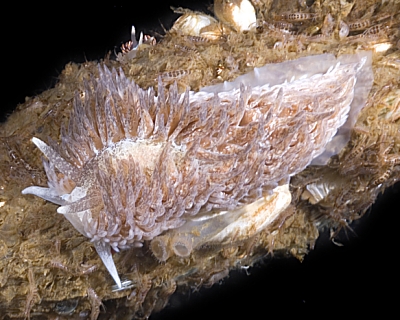
There have been some messages lately concerning this species, which seems to have "bloomed" this winter around Vancouver. We've been finding it on ropes that connect our mooring buoys on our local dive sites. Hermissenda crassicornis are also in abundance (you can see one at the top of the rope), but they're always around. Aeolidia papillosa are not a common sight at all, so a welcome addition to the usual sights.
Locality: Miller's Landing, Bowen Island, Howe Sound, 15 feet, British Columbia, Canada, Pacific, 17 March 2007, Mooring Buoy rope. Length: 20 mm. Photographer: Marli Wakeling.
Cheers,
Marli
scubamarli@gmail.com
Wakeling, M., 2007 (Mar 26) Aeolidia papillosa from British Columbia. [Message in] Sea Slug Forum. Australian Museum, Sydney. Available from http://www.seaslugforum.net/find/19712Hi Marli,
I am really looking forward to getting my hands on some specimens. Your animal here is the normal length, and similar in coloration to the southern (true) A. papillosa. In Gig Harbor, Washington, huge specimens up to 4 inches (10 cm), and a very dark speckled grey, cover the bottom of the harbor. The egg masses form huge carpets everywhere. Hopefully I can figure out this dilemma soon.
Thanks for postng this,
Dave Behrens
Aeolidia papillosa? from southern Oregon
March 1, 2007
From: Sandy Grummon
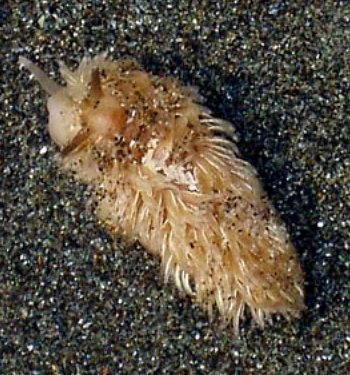
My husband and I were on the southern Oregon coast (Pacific Coast, USA) at Meyers Creek Beach during a good low tide this past July. We saw this nudibranch, and thought it looked a lot like an Aeolidia papillosa, except the coloring seemed wrong. I've looked through your archive photos, and the Aeolidia papillosa look mauve or gray color. Also, it was stranded alone in a depression in the sand, not among any aggregated anemone (Anthopleura elegantissima).
Locality: Meyers Creek Beach near the town of Gold Beach, About 3 inches of water, Oregon, USA, Pacific Ocean, 29 July 2006, Rocky intertidal. Length: Approximately 2 inches. Photographer: Bryan Grummon.
P.S. This is a GREAT website!
Sandy Grummon
sandygrumm@aol.com
Grummon, S., 2007 (Mar 1) Aeolidia papillosa? from southern Oregon. [Message in] Sea Slug Forum. Australian Museum, Sydney. Available from http://www.seaslugforum.net/find/19544Hi Sandy,
Thanks for adding to the confusion - Only kidding.
Aeolidia papillosa is certainly one of the most common species found around the world in temperate seas. Its color appears to be quite variable, depending upon locale and food resources. While the white stripes along the edge of each ceras are new to me, the remaining external characteristics suggest that your ID is correct.
Currently I am investigating the northern Pacific variant shown in recent messages to the Forum [#12014; #13178; #19141 ]. It is possible, that due to the size of the northern, dark color animals might be a species described by Rudolph Bergh in 1894 as Aeolidia herculea. I am afraid we will have to wait for the results of this study. In the mean time, it is best to call all the colors on this coast Aeolidia papillosa.
Thanks
Dave Behrens
Large Aeolidia papillosa from Puget Sound
February 8, 2007
From: Richard Zade
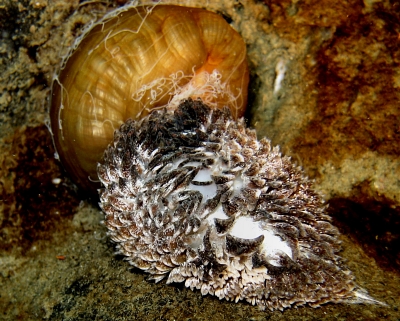
I depend on Dave Behrens book as my bible for Nudibranch id's but I have noticed that the Aeolidia papillosa shown in his book looks nothing like the ones we are used to up here in the Puget Sound area of Washington state. and the size range seems small although I am not that good with the metric system. I thought he had left out these interesting little guys as I didn't know the scientific name.
Up here we call them the 'shaggy mouse' for good reason. They range in color from gold to dark brown with the majority in shades of brown or grey and resemble their namesake very much. I was wondering why ours are so dark. Could it be a subspecies or maybe just because there is so much dark color present in our waters up here. Their main food up here is the plumose anemone as you see in the upper picture.
Locality: Point Hudson, Port Townsend , 20 to 45 feet, Washington state USA, Puget Sound, Pacific Ocean, 23 December 2006, rocky breakwater with sandy bottom. Length: 3 to 4 inches. Photographer: Richard Zade.
Richard Zade
rzade@hotmail.com
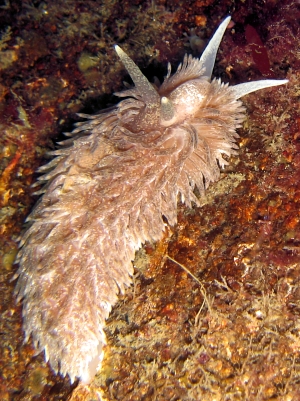
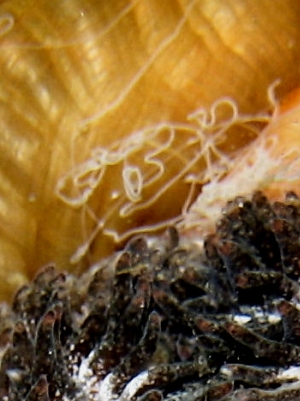
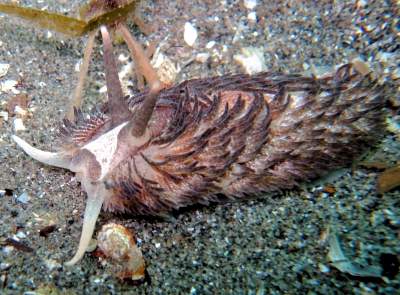
Rich:
Your Bible - I hope not, just a guide book that I hope is helpful to all the slug enthusiasts along this coast. Thanks for the compliment however.
Yes, I must admit since I have moved to the great State of Washington and begun diving here, the example of Aeolidia papillosa in the book does send an inaccurate message of just how widely variable the color of this species can be. In Puget Sound this species is huge, up to 10 cm (4 inches) or more, and I have yet to find a pale white specimen, like that used in the latest edition of the book (with Ali Hermosillo, as coauthor). Specimens up here are colored, as you have provided here, white with dense dark pigmentation. I used to think the color of Aeolidia was derived from its cnidarian prey (in California those eating white Metridium are white, those eating the copper colored variant of the anemone have an orange hue, and those feeding on Epiactis or Anthopleura are green. Now I am confused. In Puget Sound, the Metridium are either white or copper/orange. Where the slug gets, or how it manufactures, the black pigmentation intrigues me. This would make a great Master's Thesis topic.
Bill has included a great little crop for us showing acontia (the white threads seen in the first and third photos). Acontia are one of several defense mechanisms sea anemones use against their predators. Predators targeting the tentacles of the cnidarian are stung with nematocysts released from the tentacles. Those, like Aeolidia, who attack the column of the anemone, are subjected to the release of acontia, thread-like extensions of the gastrovascular cavity of the anemone, which also bare microscopic harpoon-like nematocysts, for the purpose of stinging and dissuading the perp.
Great observation,
Dave Behrens
Juvenile Aeolidia papillosa?
May 11, 2006
From: Carmelita Hansen

We found this small nudibranch in about 70 feet of water in Carmel Bay, California. Our best guess at identification is a juvenile Aeolidia papillosa. Is this what we are looking at, or are we mistaken?
Locality: Point Lobos, Carmel, 70 feet, California, USA, Pacific, 30 March 2006, rocky bottom. Length: 1 inch. Photographer: Carmelita Hansen.
Thanks.
Carmel Hansen
mhel0323@sbcglobal.net
Hansen, C., 2006 (May 11) Juvenile Aeolidia papillosa?. [Message in] Sea Slug Forum. Australian Museum, Sydney. Available from http://www.seaslugforum.net/find/16232
Hi Carmel,
Yes indeed, this is a young Aeolidia papillosa. In your area the species feeds largely on the sea anemone, Metridium senile, giving the slug the white coloration. When individuals in the intertidal feed on Epiactis, they are more of a olive green tint.
When identifying this species, you will alway see a wide clearing down the center of the dorsum and the cerata begin in front of the rhinophores. The white patches on your specimen are very common.
Thanks,
Dave Behrens
Aeolidia papillosa - Mating and Feeding
May 24, 2005
From: Philipp Kauffmann
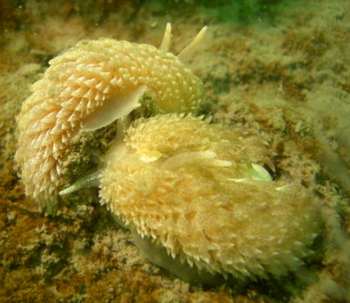
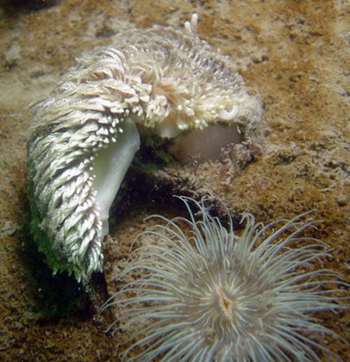
Hello everybody,
Here are two pictures showing two seaslugs. Is it Aeolidia papillosa or Aeolidiella glauca? It looks like they pairing. If yes, how do they do it?
The third picture shows a single Aeolidia papillosa. Is she feeding on the sea anemone Sagartia troglodytes?
Locality: Oosteschelde, Netherlands. Depth: 10 m. Length: 6-7 cm. 16 May 2005. Photographer: Philipp Kauffmann
Thanks a lot!
Philipp
philipp@dive2paradise.de
Kauffmann, P. F., 2005 (May 24) Aeolidia papillosa - Mating and Feeding. [Message in] Sea Slug Forum. Australian Museum, Sydney. Available from http://www.seaslugforum.net/find/13822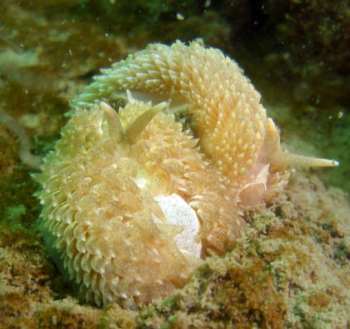
Dear Philipp,
These are all Aeolidia papillosa. You can see traces of the white V marking this species has on the head. The arms of the V run out on to the oral tentacles. In your feeding photo it looks like the animal has its oral tube everted out over another anemone. Or perhaps it is out in preparation for attacking the one in your photo. This species feeds on a variety of sea anemones.
I guess the animals in your photo alongside are mating - or preparing to. All nudibrnachs are hermaphrodite, with a full set of male and female organs. At mating they usually both act as male and female. As the reproductive openings are on the right side of the body, when you see two individuals with their right sides together, you can be fairly confident that they are mating, or about to.
Best wishes,
Bill Rudman
Aeolidia papillosa from Puget Sound, Washington
February 22, 2005
From: Tom Hankins
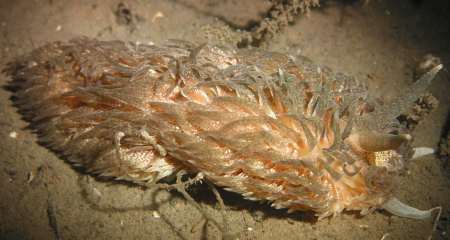
Is anyone able to identify this sea slug?
Locality: Les Davis Fishing Pier, Puget Sound, Washington, USA. Depth: 40 Feet. Length: 6 Inches. 17 February 2005. Muddy bottom. Photographer: Tom Hankins.
Tom Hankins
ttommy69@hotmail.com
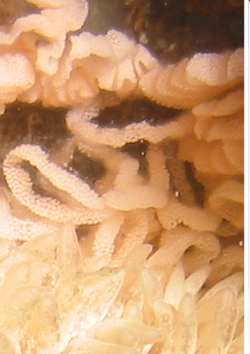
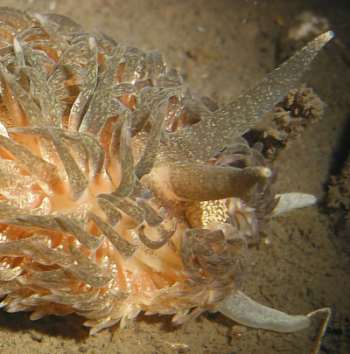
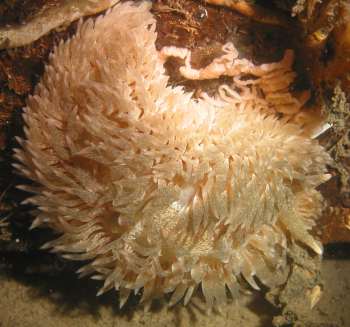
Dear Tommy,
This is Aeolidia papillosa, a large aeolid nudibranch which has a wide distribution on both the Atlantic and Pacific coasts of Nth America and also the Atlantic coast of Europe. There are in fact 2 animals in your upper photo, one following the other, the back one having its head under the foot of the front one. In the photo to the right of my reply you can see a single animal which has apparently been laying its eggs. Right above my reply I have included a close-up of the egg ribbon [on left] and a close-up of the head [on right]. Have a look at the Fact Sheet and the other messages on the Forum about this species for more information.
Best wishes,
Bill Rudman
Aeolidia papillosa vs Flabellina salmonacea
January 29, 2004
From: Mary Jo Adams
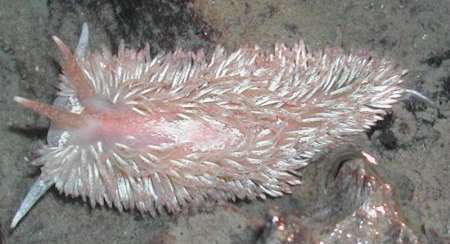
Hi,
We commonly find Aeolidia papillosa at Rosario Beach (Fidalgo Island, Washington, USA). We spotted this 2 inch nudibranch last week and it looked different as the cerata did not cover the anterior tip of the nudibranch. Looking it up, we thought it might be Flabellina salmonacea but weren't sure. Can you tell from the photo which species it is?
Thank you.
Mary Jo
mjadams52@hotmail.com
Adams, M.J., 2004 (Jan 29) Aeolidia papillosa vs Flabellina salmonacea. [Message in] Sea Slug Forum. Australian Museum, Sydney. Available from http://www.seaslugforum.net/find/12014Dear Mary Jo,
From the general shape of the body - very broad with numerous rows of cerata - make me certain that this is Aeolidia. If you look at other photos of Aeolidia papillosa in the attached messages you will see that the cerata don't always cover the front of the animal.
Best wishes
Bill Rudman
Aeolidia papillosa - mating
August 29, 2003
From: Richard Lord
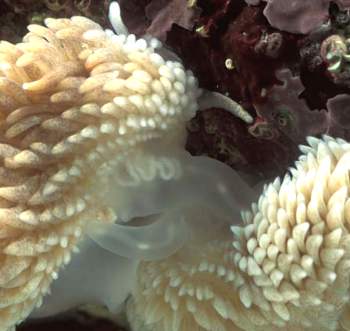
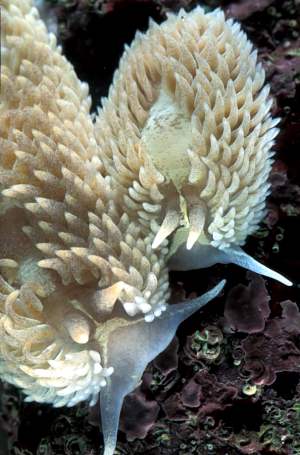
Dear Bill:
On 2 August, 2003, crab potter Clive Brown brought me two Aeolidia papillosa from his crab pots off the south coast of Guernsey, English Channel. The dissimilar sized aeolids were nestled together. I put them in an aquarium and they separated. On 3 August shortly after 2200 I removed them from one aquarium and placed them in a smaller aquarium for photography. I placed a crustose coralline algae covered rock in the aquarium with them. The rock measured 6 x 5 x 2 inches. The larger aeolid 'explored' the rock by circling it several times. The smaller aeolid moved to a depression in the rock and settled in it. As the larger aeolid was 'exploring' the rock it bumped into the smaller aeolid several times. On each occasion the smaller aeolid flared its cerata (defensive mechanism?). On the third encounter the two aeolids settled together (head to tail) and at about 2230 they transfered gametes to each other simultaneously. This occurred in less than 30 seconds as, although I didn't time it, I was able to take only two photos of the event (because my flashes were slow to recharge.)
The two aeolids remained touching each other for 15 minutes but during this time the larger aeolid turned around. At this point I left them until the following day. No eggs had been laid in the aquarium by the time I returned them to the sea the following morning.
Richard Lord
fishinfo@guernsey.net
Lord, R., 2003 (Aug 29) Aeolidia papillosa - mating. [Message in] Sea Slug Forum. Australian Museum, Sydney. Available from http://www.seaslugforum.net/find/10857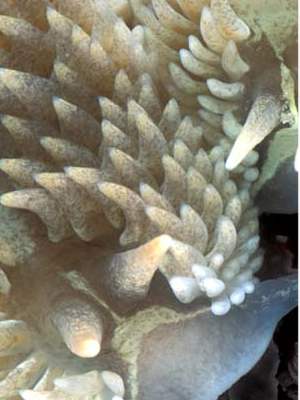
Dear Richard,
Thanks for these interesting observations. I have also included a close-up of the head to show the milky yellow bands around the rhinophores and cerata of these specimens. In fact the opaque white markings on the dorsum have a definite yellow tinge as well.
Best wishes,
Bill Rudman
Aeolidia papillosa feeding
August 23, 2003
From: Alan Shepard
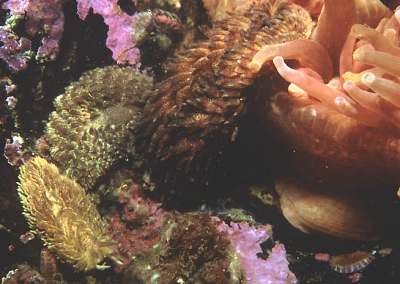
Bill,
Here is another shot taken in Eastport, Maine, USA. Here are three Aeolidia papillosa, locally called the 'maned nudibranch', one of which is feeding on a norhtern red anemone (Urticina felina).
A. papillosa is common in New England and the easiest way to find them is to search near their anemone prey. When they are curled up, A. papillosa can easily be mistaken for an anemone.
Finding three of this species together yet of differing coloration was quite interesting.
Best wishes,
Alan Shepard
Tolland, CT, USA
alan.chepard@snet.net
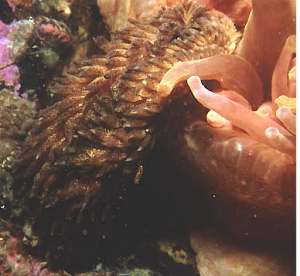
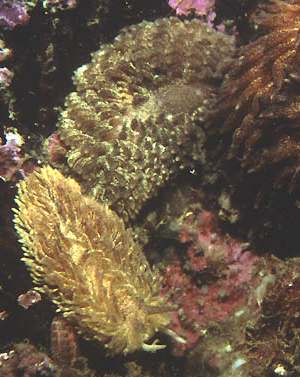
Thanks Alan,
Bill Rudman
Re: Information about Aeolidia papillosa
November 4, 2002
From: Peter H. van Bragt
Hello Bill,
Concerning Moria's query: I have send this message to Moria. Maybe you want to post it on the Forum as well?
Dear Moria,
I am a Nudibranch observer in the Netherlands and so I cannot give you any numbers or information on the presence of A. papillosa in Puget Sound. But it is a common species in the Netherlands. In the estuary in the South-west of the Netherlands we have three different types of marine waters: brackish non-tidal, salt water (3.2% NaCl) non-tidal and Saltwater (3.2%) tidal waters. In these three waters we see a remarkable difference in the presence of A. papillosa and the related species Aeolidiella glauca. A. papillosa is mostly present in the tidal saltwater area. It seems to feed here mainly on the sea anemones Metridium senile and Sagartia troglodytes. I cannot give you precise details on the numbers but it is a common species which can be found throughout the year, but it is most abundant during late winter, spring (mating season) and early summer. A. glauca is also common here, mainly present in spring, summer and early fall but numbers are smaller.
In the saltwater non-tidal area A. glauca is more common than A. papillosa, which is present in much smaller numbers than in the tidal area. Both anemones on which it feeds are also less abundant here. In the brackish waters, where the food is even less abundant, we hardly find any specimen of these species. Therefore I would like to conclude that the presence of A. papillosa, but also other nudibranchs (and this is obviously a known parameter) is directly linked to the presence of available food sources. The presence of these food sources are of course also linked to various parameters like, salt concentration, tidal water, water temperatures, food sources etc. etc.
http://www.anemoon.org/anm/soorten/82300.htm shows a distribution map of A. papillosa in the Netherlands.
http://www.anemoon.org/anm/soorten/82400.htm shows a distribution map of A. glauca in the Netherlands
http://www.anemoon.org/soorten/mollusca/Aeopap04.html shows the seasonal distribution of A. papillosa in the Oosterschelde (tidal) and Grevelingenmeer (non tidal)
http://www.anemoon.org/soorten/mollusca/Aeogla04.html shows the seasonal distribution of A. glauca in the Oosterschelde (tidal) and Grevelingenmeer (non tidal)
I hope this information can help you with your project.
With best regards
Peter H. van Bragt
vanbragt.phjm@hsbrabant.nl
van Bragt, P.H., 2002 (Nov 4) Re: Information about Aeolidia papillosa. [Message in] Sea Slug Forum. Australian Museum, Sydney. Available from http://www.seaslugforum.net/find/8346Thanks very much Peter,
I am glad to post your note to Moria. I certainly encourage the sharing of substantial contributions such as this by posting them on the Forum. Answering ecological essay questions like this about marine animals is very difficult for students. Once you get past the obvious parameters, such as food and water, discussing the importance of other possible parameters in limiting population size becomes almost metaphysical in its complexity because of the difficulty in defining what constitutes a 'population'.
Best wishes,
Bill Rudman
Information about Aeolidia papillosa
October 30, 2002
From: Moria Eggers
Hi,
I am a student at the University of Puget Sound in Tacoma, Washington. I am doing a literature based project for my marine biology class and I have chosen to look at Aeolidia papillosa. I was curious to know population numbers and predators of this species in the Puget Sound area. My question is what is limiting the population sizes of the nudibranch Aeolidia papillosa?
Thanks
Moria Eggers
meggers@ups.edu
Eggers, M., 2002 (Oct 30) Information about Aeolidia papillosa. [Message in] Sea Slug Forum. Australian Museum, Sydney. Available from http://www.seaslugforum.net/find/8316Dear Moira,
If you look at the Fact Sheet on this species you will find a link to a page of relevant references on aspects of its natural history and ecology.
One problem with questions such as 'what is limiting the population size' is that they make assumptions so you can discuss ecological theory which is based on an 'ideal world'. The first question you need to ask is whether the population size of Aeolidia papillosa is being limited at all, and if so is it just being limited in one place or at one point in time. Which brings up the question about how you define a 'population' in a marine animal which may lead its adult life in one place bbut has arisen from larvae which have come from somewhere else. All very difficult. When you have marine animals, with planktonic larval stages, the size of the benthic population at one place is often dependent on the reproductive success of a benthic population at some other place, and the ability of the resulting larvae to survive in the plankton and finally settle. So the nice feedback mechanisms built into ecological theory which relate population size to fecundity and health of the breeding population break down, because even the most healthy and satiated population can crash if there is no larval settlement.
Good luck with your report,
Best wishes,
Bill Rudman
Aeolidia papillosa feeding
September 30, 1999
From: Andy Horton
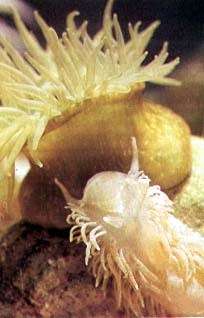
Hello Bill,
Aeolidia papillosa is known as the Grey Sea Slug in England (from the popular books).
I thought the visitors to the site would like to see a photograph of the nudibranch actually trying to eat a sea anemone. The prey is a green Beadlet Anemone, Actinia equina. It did not pursue its attempt. The anemone will usually close its tentacles when attacked. When given a choice of sea anemones in an aquarium it seemed to prefer smaller anemones of the species Metridium senile and Sagartia troglodytes. Both the predator and prey were from the Sussex coast, England, (English Channel. It was not succesful at tackling the Snakelocks Anemone, Anemonia viridis. Specimens (about 200 examples) from the Sussex coast do not exceed 50 mm in length very often, the maximum size only 60 mm. However, on the Dorset coast (English Channel) they attain 120 mm.
I noticed the spawn looked different from the other photographs. The spawn illustration was photographed in the wild. Even when making allowances for differences between individuals, the spawn still looks slightly different.
Any comments appreciated.
Andy Horton
bmlss@compuserve.com
Horton, A., 1999 (Sep 30) Aeolidia papillosa feeding. [Message in] Sea Slug Forum. Australian Museum, Sydney. Available from http://www.seaslugforum.net/find/1387Thanks Andy,
We're building quite a bit of information on Aeolidia papillosa. I must say 'Grey Sea Slug' is a pretty boring name for such an interesting animal.
Concerning your eggmass photo. It does look a bit more tightly packed than the earlier photos but that seems to be the normal sort of variation you find in nudibranchs. The most characteristic feature of the egg mass seems to be how the ribbon is constricted into partitions, a bit like a string of sausages. Such an egg mass is not exclusive to this species, but it is not found in all aeolids.
Thanks for your enthusiastic participation,
Bill Rudman.
Aeolidia papillosa spawn
September 29, 1999
From: Andy Horton
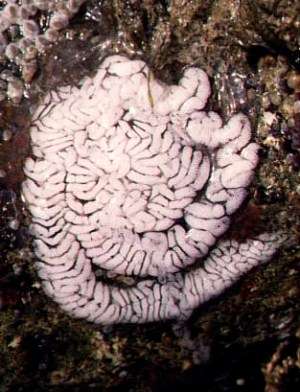
Dear Bill,
Here is the spawn of Aeolidia papillosa on the underside of a flint rock, spring, Brighton, Sussex, England. English Channel coast. Photograph by Andy Horton.
Further details at British Marine Life Study Society website
Andy Horton
Director and founder of the British Marine Life Study Society, England, UK.
bmlss@compuserve.com
Horton, A., 1999 (Sep 29) Aeolidia papillosa spawn. [Message in] Sea Slug Forum. Australian Museum, Sydney. Available from http://www.seaslugforum.net/find/1378Albino Aeolidia papillosa
September 18, 1999
From: Irina Roginskaya
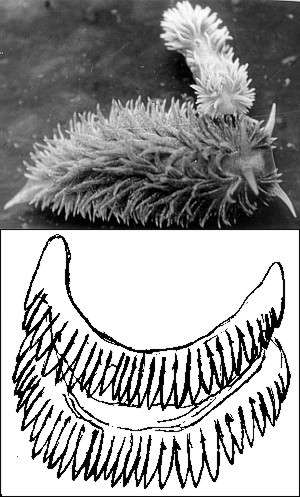
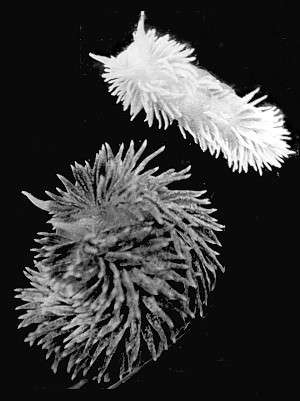
Dear Bill,
Here are two photos of albinistic specimen of Aeolidia papillosa from the White Sea. It seems to me that the records of albinos among nudibranchs are rather rare (with the exception of cave dwellers. e.g., (Belcik, 1975; Cattaneo, 1982) and deep-water species (e.g. Rudman, 1972)). During my more than 20 years long searching for nudibranchs in the vicinity of the White Sea Biological Station of Moscow State University I had seen the albinistic exemplar only once. This white specimen of Aeolidia papillosa (L) was discovered 19.09.1987 at low tide near the White Sea Biological Station of Moscow State University (Kandalasha Bay, Velikaya Salma Strait), in a shallow residual pool on the silty-sandy rather polluted bottom near the pier, in company of four normally pigmented grayish brown A. papillosa. The white specimen differed from its normal fellows by the complete absence of pigmentation, by the much lesser size - 3cm in length, (while the four normally pigmented A.papillosa attained 6.0-7.5 cm), and by the group of rows with short regenerating papillae on the right side of the body.
The behaviour of the white and the four normally coloured specimens was just the same. Regaining with returning water their usual lively appearance (after forced immobility during low tide) the five animals together rushed towards the place of aggregation of their food objects - the olive-green actiniarians Bunodactis stella almost buried up to the oral disk in the sand. In captivity being accustomed to twice a day drying the white specimen together with other A. papillosa at the time of low tide tried to climb out from the aquarium.
Despite the milky white coloration of the body and cerata the specimen retained some colour peculiarities of normally coloured A. papillosa. That is, the opaque snowy-white “dust” more white that the milky-white background, clearly seen on the upper 2/3 of each dorsal papilla, on the basic part of the rhinophores and the oral tentacles, and especially on the upper surface of the head, where the dense snowy-white specs of “dust” created the triangle, which is characteristic for the species. The anatomical study of the white specimen revealed the usual radula, composed of 23 rows of pectinate teeth and the normally pigmented black eyes.
Externally the white specimen was looking like the true albino. Though if the albinism is innate genetic anomaly, linked with the blocking of the synthesis of pigments, mainly melanin, the retain of eye pigmentation permits us to speak only about the partly albinism. The presence of the melanin in the eyes points to the presence of the dominant gene of normal pigmentation, necessary for the elaboration of pigment in the organism. Perhaps here we are dealing with albinism arising as the display of the gene of patchiness, when the whole surface of the body may prove to be the single white spot, and then the albinos may retain eye pigmentation?
Roginskaya, I.S. (1990) Albino Aeolidia papillosa, collected in the intertidal zone of the White Sea (Gastropoda, Nudibranchia). Zoologicheskiy Zhurnal (Russian Journal of Zoology), 69(3): 125-127. (in Russian).
Irina Roginskaya
irina7@hotmail.com
Roginskaya, I., 1999 (Sep 18) Albino Aeolidia papillosa. [Message in] Sea Slug Forum. Australian Museum, Sydney. Available from http://www.seaslugforum.net/find/1349Dear Irina,
Thanks for the information.
Bill Rudman
Aeolidia papillosa from the White Sea
September 8, 1999
From: Irina Roginskaya
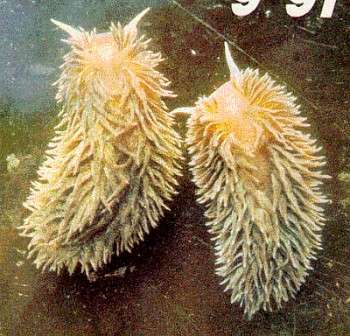
Dear Bill!
Are you interested in Aeolidia papillosa from the White Sea? Here are photos of A. papillosa collected near the White Sea Biological Station of Moscow State University at Kandalaksha Bay. The one in colour and a specimen, eating the actiniarian, I took in September 1987; the specimen sliding over sandy bottom - a year earlier. A. papillosa is one of the commonest nudibranchs in the vicinity of the Biological Station and one of the largest : some specimens could attain as long as 70 mm. They are preying on two species of actiniarians: Bunodactis stella (Verrill) (= Aulactinia stella (Verrill) according to Dunn,Chia and Levine, 1980) in the littoral environment, and on Metridium senile (Verrill) in the sublittoral zone. During the long spawning period of A. papillosa, from June up to the end of September, the spirally coiled festoon shaped egg-strings of the species can be regularly seen attached to the stems of Zostera, stones and empty shells of Bivalvia. The largest egg-masses may contain up to millions of eggs. Producing the large egg masses may take A. papillosa as much as 16-18 hours. There are usually more than one egg in the egg-capsule, sometimes - up to 19 eggs. The diameter of the fertilized eggs is 78-80 microns.
P.S. The colour photo had been published in Roginskaya I.S. & Reller N.B. (1991) Nudibranchia versus Cnidaria, Priroda, 9: 64-70.
Best wishes,
Irina.
irina7@hotmail.com
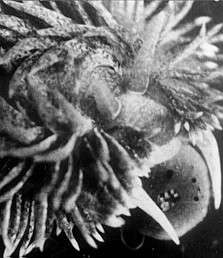
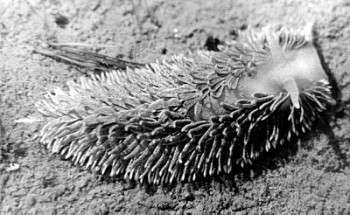
Dear Irina,
Of course we're interested in Aeolidia from the White Sea. The photo of it eating the small anemone is interesting because it seems to be exhibiting the behaviour I described for Spurilla australis in Australia. I have only seen S. australis feeding on a relatively small anemone, Cricophorus nutrix which lives on laminarian brown algae. The anemone quickly releases its hold on the algae when disturbed, so that it falls off and escapes. In an apparent behavioural 'trick' to avoid losing the anemone, Spurilla australis wraps its oral tentacles around the anemone as it takes a bite. This seems to be what your Aeolidia is doing in the photo.
Bill Rudman.
Colour variation in Aeolidia papillosa
September 5, 1999
From: Betsey Hansen
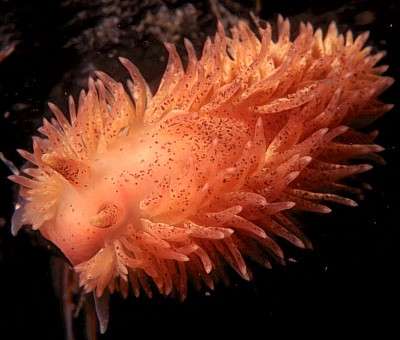
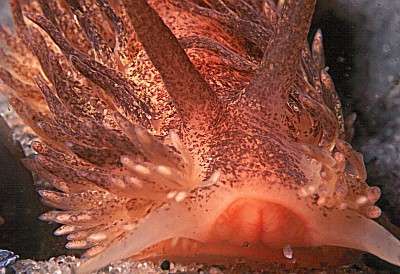
Dear Bill,
Here are photos of the dark brown and orange forms of Aeolidia papillosa I find off New York.
Betsey Hansen.
BHScuba@aol.com
Hansen, E., 1999 (Sep 5) Colour variation in Aeolidia papillosa. [Message in] Sea Slug Forum. Australian Museum, Sydney. Available from http://www.seaslugforum.net/find/1278Aeolidia papillosa - Feeding & breeding
September 3, 1999
From: Betsey Hansen
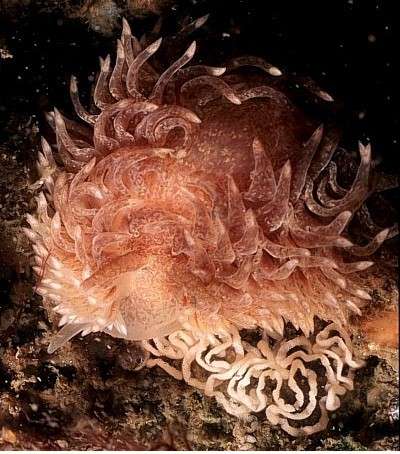
Bill,
Here are some more of the photos of Aeolidia papillosa that I promised. There is one [upper right] of it eating an anemone, one showing egg laying, and one of an orange egg ribbon.
I've often wondered if their coloration or the color of the eggs is dependent on the color of the anemones that it eats. The anemones vary in color from brown to orange to white.
Betsey Hansen
BHScuba@aol.com
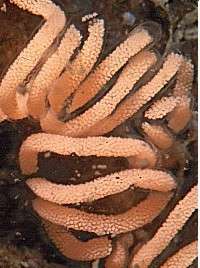
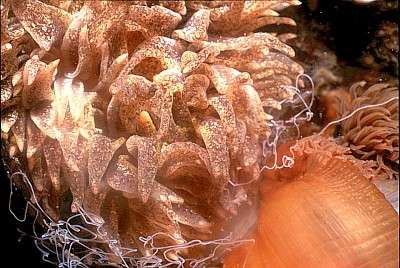
Dear Betsy,
Thanks for the photos. It's really good to get photos of animals 'doing things'.
Concerning colour differences. In many opisthobranchs the eggs change colour as the embryo develops in the egg capsule. I am not sure if that is the case with Aeolidia papillosa but it looks as though the eggs being laid are white. Perhaps they go orange as they develop? Have you seen orange ones being laid?
The colour of the animal can also be affected by the colour of the food they eat. I show on another page that many nudibranchs use food pigments as camouflage, and the ceratal colour of many aeolids is dependent on the colour of their food. I am not sure if there is any published accounts but I have seen a related aeolid here in Australia, Aeolidiella foulisi change skin colour depending on the colour of the sea anemones it had to feed on.
One interesting feature you can see in the photo of Aeolidia eating the sea anemone are the white sticky defensive threads or 'acontia'. They sit in sacs at the base of the tentacles and are only brought into action by the anemone when it is under attack. The sticky threads are armed with specialised stinging cells (nematocysts) but they don't seem to be having much effect on the slug.
I have added a list of publications referring to aspects of the biology of Aeolidia papillosa.
Bill Rudman.
Rudman, W.B., 1999 (Sep 3). Comment on Aeolidia papillosa - Feeding & breeding by Betsey Hansen. [Message in] Sea Slug Forum. Australian Museum, Sydney. Available from http://www.seaslugforum.net/find/1279Aeolidia papillosa from the Netherlands
September 2, 1999
From: Peter H. van Bragt
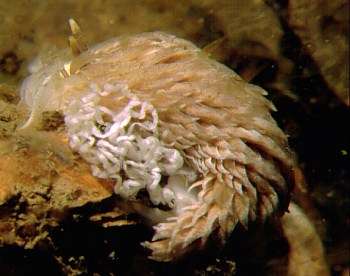
Dear Bill,
Here is a photo of Aeolidia papillosa to add to the Netherlands' List.
Location: Zeelandbrug, Zierikzee, Oosterschelde, The Netherlands, 25 April 1999
With best regards
Peter H. van Bragt
Peter.vanBragt@ftn.hsbrabant.nl
van Bragt, P.H., 1999 (Sep 2) Aeolidia papillosa from the Netherlands. [Message in] Sea Slug Forum. Australian Museum, Sydney. Available from http://www.seaslugforum.net/find/1170Thanks Peter,
I am also adding some photos today from North America which make an interesting comparison.
Bill Rudman.
Aeolidia papillosa from New York
September 2, 1999
From: Betsey Hansen
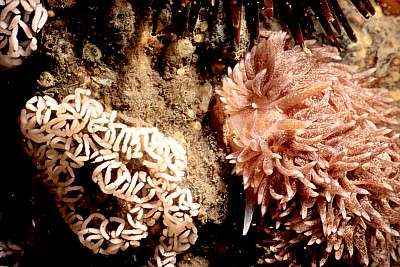
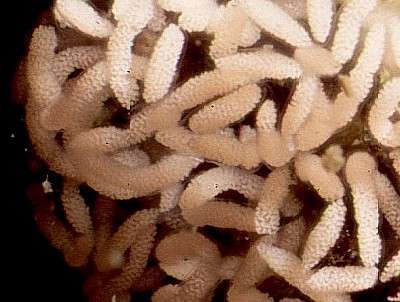
Bill,
I identified this one as Aeolidia papillosa from Andrew J. Martinez's book
"Marine Life of the North Atlantic," however, my luck with identifying these on my own has been terrible. This is the most common sea slug in my area.
This shot was taken at about 12 feet (4 meters) in the Atlantic off New York. You can see the eggs to the left. I have hundreds of pictures of these slugs. Sometimes the eggs are white and sometimes orange. The coloring of the slugs also ranges from orange to brown. The size ranges from one inch to four inches. This year they were particularly large. I have seen this slugs feeding on anemones. I have plenty of other shots if you want to see some more. I even have some showing them laying eggs.
Best regards,
Betsey Hansen
BHScuba@aol.com
Hansen, E., 1999 (Sep 2) Aeolidia papillosa from New York. [Message in] Sea Slug Forum. Australian Museum, Sydney. Available from http://www.seaslugforum.net/find/1272Dear Betsey,
Your identification is correct, but don't worry about getting names wrong. The identity of the species of Flabellina (=Coryphella) in the North Atlantic for most of this century has been in a state of confusion, even amongst the 'experts'. Species were named on the slightest colour differences, and little consideration was given to the possibility that a species might be found on both sides of the Atlantic.
This is why I am happy to display as much colour variation as possible. It is the only way, other than extensive personal collecting, for us to get an understanding of the range of variation within a species. So it goes without question, that I would welcome some more shots showing colour variation in A. papillosa and its eggs.
Rudman, W.B., 1999 (Sep 2). Comment on Aeolidia papillosa from New York by Betsey Hansen. [Message in] Sea Slug Forum. Australian Museum, Sydney. Available from http://www.seaslugforum.net/find/1272